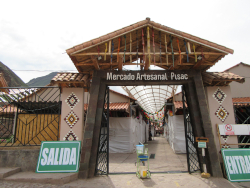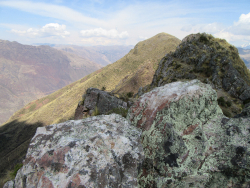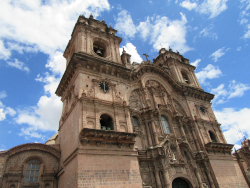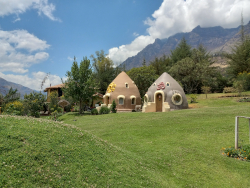What to See in Pisac
Pisac Archaeological Park
 The National Archaeological Park of Pisac is made up of groups of archaeological remains, including platforms, aqueducts,
walking trails associated with walls and portals, canalized water channels, cemeteries, bridges, etc.
The area of 4 square km is covered by these groups .
The area there inludes ruins occupying the hills. Some ruins present groups of complex arrangements,
while others are isolated constructions, separate from the other groups.
The National Archaeological Park of Pisac is made up of groups of archaeological remains, including platforms, aqueducts,
walking trails associated with walls and portals, canalized water channels, cemeteries, bridges, etc.
The area of 4 square km is covered by these groups .
The area there inludes ruins occupying the hills. Some ruins present groups of complex arrangements,
while others are isolated constructions, separate from the other groups.
Just 200 meters up the hill from the Pisac's town square rises a beautiful set of platforms. These are of 40 platforms which form a kind of a triangle with a downward vertex, that is, the smallest platform is the first one that the visitor can see when he begins to ascend. In the citadel of Pisac one can count more than twenty towers and they are of two distinct types: the dwelling towers and the watch towers. The first are conical enclosures connected to construction water channels with well-carved and assembled pieces, these look like pulpits attached to the mountain. The watch towers are beautiful elevations, they are not enclosures, their texture is solid and their interior portion is a flat surface. The most important of those is Qoriwayrachina.
 The National Archaeological Park of Pisac is made up of groups of archaeological remains, including platforms, aqueducts,
walking trails associated with walls and portals, canalized water channels, cemeteries, bridges, etc.
The area of 4 square km is covered by these groups .
The area there inludes ruins occupying the hills. Some ruins present groups of complex arrangements,
while others are isolated constructions, separate from the other groups.
The National Archaeological Park of Pisac is made up of groups of archaeological remains, including platforms, aqueducts,
walking trails associated with walls and portals, canalized water channels, cemeteries, bridges, etc.
The area of 4 square km is covered by these groups .
The area there inludes ruins occupying the hills. Some ruins present groups of complex arrangements,
while others are isolated constructions, separate from the other groups.
Just 200 meters up the hill from the Pisac's town square rises a beautiful set of platforms. These are of 40 platforms which form a kind of a triangle with a downward vertex, that is, the smallest platform is the first one that the visitor can see when he begins to ascend. In the citadel of Pisac one can count more than twenty towers and they are of two distinct types: the dwelling towers and the watch towers. The first are conical enclosures connected to construction water channels with well-carved and assembled pieces, these look like pulpits attached to the mountain. The watch towers are beautiful elevations, they are not enclosures, their texture is solid and their interior portion is a flat surface. The most important of those is Qoriwayrachina.
The Pisac Artisan Market
 It is a fair with hundreds of tents offering all kinds of unique products made by local artisans,
as well as those from nearby communities.
Looms, chullos and coats with alpaca wool, silver jewelry and ornaments, flutes, backpacks and other accessories;
all are made by hand and decorated with bright colors - very beautiful to look at.
At each step one will be amazed by all that each stand offers.
The spectacle is accompanied by beautiful sound of music by an ambulant musician wandering around.
It is a fair with hundreds of tents offering all kinds of unique products made by local artisans,
as well as those from nearby communities.
Looms, chullos and coats with alpaca wool, silver jewelry and ornaments, flutes, backpacks and other accessories;
all are made by hand and decorated with bright colors - very beautiful to look at.
At each step one will be amazed by all that each stand offers.
The spectacle is accompanied by beautiful sound of music by an ambulant musician wandering around.
The atmosphere in the cobbled streets of the market is great and kind of unique, although the crafts they sell there are easily found in other parts of Peru. They especially feature textiles made with alpaca wool and dyed in bright colors. One will find prices markedly lower than in other parts of Cusco and the prices are negociable. Besides, it is also easy to find jewelry made with silver, decorative accessories or peculiar, typically Peruvians toys. Also there are lot of crafts that reproduce Inca archaeological pieces, musical instruments, and alpaca clothing, very typical of the region which certainly will help with that cold winter of the region. This is the most popular market, and if you have some spare time you can find it very picturesque. The whole setting surrounded by mountains is beautiful.
 It is a fair with hundreds of tents offering all kinds of unique products made by local artisans,
as well as those from nearby communities.
Looms, chullos and coats with alpaca wool, silver jewelry and ornaments, flutes, backpacks and other accessories;
all are made by hand and decorated with bright colors - very beautiful to look at.
At each step one will be amazed by all that each stand offers.
The spectacle is accompanied by beautiful sound of music by an ambulant musician wandering around.
It is a fair with hundreds of tents offering all kinds of unique products made by local artisans,
as well as those from nearby communities.
Looms, chullos and coats with alpaca wool, silver jewelry and ornaments, flutes, backpacks and other accessories;
all are made by hand and decorated with bright colors - very beautiful to look at.
At each step one will be amazed by all that each stand offers.
The spectacle is accompanied by beautiful sound of music by an ambulant musician wandering around.
The atmosphere in the cobbled streets of the market is great and kind of unique, although the crafts they sell there are easily found in other parts of Peru. They especially feature textiles made with alpaca wool and dyed in bright colors. One will find prices markedly lower than in other parts of Cusco and the prices are negociable. Besides, it is also easy to find jewelry made with silver, decorative accessories or peculiar, typically Peruvians toys. Also there are lot of crafts that reproduce Inca archaeological pieces, musical instruments, and alpaca clothing, very typical of the region which certainly will help with that cold winter of the region. This is the most popular market, and if you have some spare time you can find it very picturesque. The whole setting surrounded by mountains is beautiful.
Guided Mountain Hiking
 By nature, this type of activity is endless, compared to limited places to visit in town.
Sacred Valley offers hundreds of kilometres of trails that is not possible to complete in a lifetime.
There are breath taking tops, crystal clear lakes, exotic plants, and much more.
By nature, this type of activity is endless, compared to limited places to visit in town.
Sacred Valley offers hundreds of kilometres of trails that is not possible to complete in a lifetime.
There are breath taking tops, crystal clear lakes, exotic plants, and much more.
The hiking might take one day or a couple depending on your schedule and experience. Everything is within reach, even the snow-covered hillsides albeit with some additional preparation.
The hauchuma ceremony is often accompanied by a hike. Such trails are relatively easy to complete and are guided by a local shaman.
If you're searching for a guide please contact us through this website.
 By nature, this type of activity is endless, compared to limited places to visit in town.
Sacred Valley offers hundreds of kilometres of trails that is not possible to complete in a lifetime.
There are breath taking tops, crystal clear lakes, exotic plants, and much more.
By nature, this type of activity is endless, compared to limited places to visit in town.
Sacred Valley offers hundreds of kilometres of trails that is not possible to complete in a lifetime.
There are breath taking tops, crystal clear lakes, exotic plants, and much more.
The hiking might take one day or a couple depending on your schedule and experience. Everything is within reach, even the snow-covered hillsides albeit with some additional preparation.
The hauchuma ceremony is often accompanied by a hike. Such trails are relatively easy to complete and are guided by a local shaman.
If you're searching for a guide please contact us through this website.
Sacred Valley
 Sacred Valley has many more places to visit.
Sacred Valley has many more places to visit.
Ollantaytambo
Located in the far northwest of the Sacred Valley, only a couple of hours drive from Cusco, Ollantaytambo is the last step on the way to Machu Picchu for those taking the train or hiking the Inca trail. The village is more than just a gateway to the famous Incan citadel. With its large stone terraces stacked up alongside the hills and dominated by a ceremonial centre, the archaeological site of the Ollantaytambo ruins is one of the best testimonies of the Incan architectural work. Built in the 15th century it served as a royal estate of Emperor Pachacuti and had an important defensive role during the Spanish conquest as it was the sole place to repel the invader forces.
Salt ponds of Maras
The Salt ponds of Maras also called salt mines are the only touristic sites in the Sacred Valley that aren’t Incan or Wari ruins. On the southern side of the river, between Urubamba and Ollantaytambo, these are ponds at the centre of a beautiful red canyon they have been used to collect salt from an underground water source rich in iodine since pre-Inca times. More than 500 years later, they are still in use, and today it is a cooperative consisting of local families that run the site. The number of ponds and the size of an allotment is attributed proportionally to the size of the family harvesting salt.
Agricultural terraces of Moray
The archaeologic site of Moray is located in a remote area of the Sacred Valley, about 1 hour drive from Cusco. These aren’t the type of ruins you would think of as vestiges of Inca civilisation. They aren’t, indeed, the usual building ruins you’ll see around Peru, but agricultural terraces the Inca used to experiment with.
 Sacred Valley has many more places to visit.
Sacred Valley has many more places to visit.
Ollantaytambo
Located in the far northwest of the Sacred Valley, only a couple of hours drive from Cusco, Ollantaytambo is the last step on the way to Machu Picchu for those taking the train or hiking the Inca trail. The village is more than just a gateway to the famous Incan citadel. With its large stone terraces stacked up alongside the hills and dominated by a ceremonial centre, the archaeological site of the Ollantaytambo ruins is one of the best testimonies of the Incan architectural work. Built in the 15th century it served as a royal estate of Emperor Pachacuti and had an important defensive role during the Spanish conquest as it was the sole place to repel the invader forces.
Salt ponds of Maras
The Salt ponds of Maras also called salt mines are the only touristic sites in the Sacred Valley that aren’t Incan or Wari ruins. On the southern side of the river, between Urubamba and Ollantaytambo, these are ponds at the centre of a beautiful red canyon they have been used to collect salt from an underground water source rich in iodine since pre-Inca times. More than 500 years later, they are still in use, and today it is a cooperative consisting of local families that run the site. The number of ponds and the size of an allotment is attributed proportionally to the size of the family harvesting salt.
Agricultural terraces of Moray
The archaeologic site of Moray is located in a remote area of the Sacred Valley, about 1 hour drive from Cusco. These aren’t the type of ruins you would think of as vestiges of Inca civilisation. They aren’t, indeed, the usual building ruins you’ll see around Peru, but agricultural terraces the Inca used to experiment with.
Cusco
 The Incas empire capital, Cusco, is just 33 kilometres away from Pisac.
Take a bus there for 5 soles or a taxi for 60.
The Incas empire capital, Cusco, is just 33 kilometres away from Pisac.
Take a bus there for 5 soles or a taxi for 60.
Santo Domingo and Coricancha
The church of Santo Domingo is built on the ruins of the famous Inca site of Coricancha, the Templo del Sol or Temple of the Sun. Coricancha means golden courtyard, and its walls were once lined in sheets of solid gold.
Sacsayhuaman
The massive fortified complex of Sacsayhuaman is the most significant ruin in Cusco, and is so close to the historic center that you can walk there. Sacsayhuaman is thought to have had both military and religious significance.
Plaza de Armas
It has been the heart of Cusco from the time of the Inca Empire, when the square was called Huacaypata or Aucaypata. The cathedral, on the northeast side of the Plaza de Armas is the main attraction, and you'll often find both locals and tourists relaxing on its steps.
Cathedral
Construction of the cathedral began in 1559 and was completed in 1669. It is built on the site where the Inca Wiracocha's palace once stood. The three-aisled nave of the Renaissance-style church is supported by 14 massive pillars, remarkably few for such a large nave.
 The Incas empire capital, Cusco, is just 33 kilometres away from Pisac.
Take a bus there for 5 soles or a taxi for 60.
The Incas empire capital, Cusco, is just 33 kilometres away from Pisac.
Take a bus there for 5 soles or a taxi for 60.
Santo Domingo and Coricancha
The church of Santo Domingo is built on the ruins of the famous Inca site of Coricancha, the Templo del Sol or Temple of the Sun. Coricancha means golden courtyard, and its walls were once lined in sheets of solid gold.
Sacsayhuaman
The massive fortified complex of Sacsayhuaman is the most significant ruin in Cusco, and is so close to the historic center that you can walk there. Sacsayhuaman is thought to have had both military and religious significance.
Plaza de Armas
It has been the heart of Cusco from the time of the Inca Empire, when the square was called Huacaypata or Aucaypata. The cathedral, on the northeast side of the Plaza de Armas is the main attraction, and you'll often find both locals and tourists relaxing on its steps.
Cathedral
Construction of the cathedral began in 1559 and was completed in 1669. It is built on the site where the Inca Wiracocha's palace once stood. The three-aisled nave of the Renaissance-style church is supported by 14 massive pillars, remarkably few for such a large nave.
Medicinal Ceremonies
 Peru is the only country in the world where such things as Ayahuasca or Huachuma are legal.
Traditionally consumed for centuries by Quechua people they are still in high demand.
Especially among those western refugees tired of their governments that tell them how to treat their bodies.
It is ALMOST admitted by modern science that Ayahuasca has antidepressant and anxiolytic effects.
It is also noticed that people tend to drink less alcohol after a couple of ayahuasca ceremonies.
True or false, do not consider taking it for pleasure, like a glass of wine.
Find a shaman experienced in Ayahuasca consommation, e.g., Peruvian native.
He will guide you through the whole process, so you'll get much more than a simple physical sensation.
Peru is the only country in the world where such things as Ayahuasca or Huachuma are legal.
Traditionally consumed for centuries by Quechua people they are still in high demand.
Especially among those western refugees tired of their governments that tell them how to treat their bodies.
It is ALMOST admitted by modern science that Ayahuasca has antidepressant and anxiolytic effects.
It is also noticed that people tend to drink less alcohol after a couple of ayahuasca ceremonies.
True or false, do not consider taking it for pleasure, like a glass of wine.
Find a shaman experienced in Ayahuasca consommation, e.g., Peruvian native.
He will guide you through the whole process, so you'll get much more than a simple physical sensation.
Do not hesitate to contact us for a reference.
 Peru is the only country in the world where such things as Ayahuasca or Huachuma are legal.
Traditionally consumed for centuries by Quechua people they are still in high demand.
Especially among those western refugees tired of their governments that tell them how to treat their bodies.
It is ALMOST admitted by modern science that Ayahuasca has antidepressant and anxiolytic effects.
It is also noticed that people tend to drink less alcohol after a couple of ayahuasca ceremonies.
True or false, do not consider taking it for pleasure, like a glass of wine.
Find a shaman experienced in Ayahuasca consommation, e.g., Peruvian native.
He will guide you through the whole process, so you'll get much more than a simple physical sensation.
Peru is the only country in the world where such things as Ayahuasca or Huachuma are legal.
Traditionally consumed for centuries by Quechua people they are still in high demand.
Especially among those western refugees tired of their governments that tell them how to treat their bodies.
It is ALMOST admitted by modern science that Ayahuasca has antidepressant and anxiolytic effects.
It is also noticed that people tend to drink less alcohol after a couple of ayahuasca ceremonies.
True or false, do not consider taking it for pleasure, like a glass of wine.
Find a shaman experienced in Ayahuasca consommation, e.g., Peruvian native.
He will guide you through the whole process, so you'll get much more than a simple physical sensation.
Do not hesitate to contact us for a reference.
